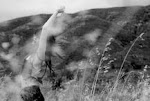
The works of Uruguayan artist, Carlos Paez Vilaro, are on view at the Museum of Tigre this month.
Paez Vilaro is not just a painter, he has used and related to art in every way he thought imaginable. He has worked on murals, ceramics, sculpting, etching, collage and photography, he has researched Afro-Uruguayan culture and music for years; plays a percussion instrument called tamboril to the beat of "candombe" (popular music in Uruguay that has its roots in Africa), he has written "candombe" lyrics, poems and published several books.
At the age of 6 he got interested in art, he drew pictures he sent to children's art contests in Buenos Aires. Always feeling attracted to Buenos Aires, as a teenager he crossed the river that divides both countries and came to work. He got a job sticking the heads of matches at a factory and lived in a rented room in a hotel for people with low incomes, similar to a "conventillo". There, he discovered his passion for immigrants and the way their cultures mixed with ours. He liked music and dances which he attended in order to draw pictures of the couples in the dance floor.
The way he has lived through art is surprising. He has exchanged his work in order to pay for many of his expenses. Painting is what made him feel like doing things in life, it opened many doors for him: the door to the world and the door to meeting interesting people and making friends.
He took architecture to new limits when he built his iconic paradise in Punta Ballena, Uruguay: "Casa Pueblo", located on a bay, overlooking the sea, made of curvy lines in immaculate white. The idea of "conventillos" inspired his creation of this place. It has a museum, an atelier and a hotel.

His second version of Casa Pueblo was constructed in Tigre, Buenos Aires, his home in Argentina. He discovered the place by chance while on a walk with his wife on the banks of the river.
Maybe it’s thanks to art that Carlos Paez Vilaro found unimaginable strength that kept his hope alive in the most adverse situation. In 1972, the plane that took his son, Carlitos to a rugby tournament in Santiago de Chile, fell in the Andes mountains. A small group survived 72 days in the snowed peaks of the Andes. Paez Vilaro travelled to Chile along with other relatives to support the search of the plane and possible survivors. When the search officially concluded and there was no more hope left, he continued looking. When relatives began to return to Uruguay, he stayed and continued to hope. People thought he was crazy.

When he was finally boarding his plane home, he heard the crew talking to the airport Police that had come looking for him. A shepherd had seen two young men in the mountains. Carlos ran to a taxi and told the driver he had no money. The taxi driver placed his wallet on his knee and said: "take what you need". His son was alive: " I had whistled behind the Andes to let Carlitos know I was there, while the moon was looking at me from the sky".

We hope you have a chance to see the heartfelt work of this artist and to visit Casa Pueblo in Punta del Este, Uruguay.
Post by: Valeria Peimer





































